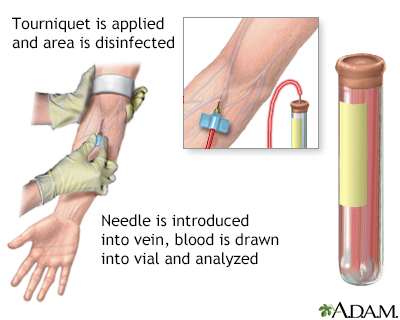Quantitative immunoglobulins
The quantitative immunoglobulins test measures the levels of proteins called gamma globulins in the fluid part of a blood sample. This fluid is called serum.
Images

I Would Like to Learn About:
How the Test is Performed
A blood sample is needed.
In the lab, the technician places the blood sample on special paper and applies an electric current. The proteins move on the paper and form bands that show the amount of each protein.
How to Prepare for the Test
Follow instructions on whether or not you need to fast before this test.
Certain medicines may affect the results of this test. Your health care provider will tell you if you need to stop taking any medicines. Do not stop any medicine before talking to your provider.
How the Test will Feel
When the needle is inserted to draw blood, some people feel moderate pain. Others feel only a prick or stinging. Afterward, there may be some throbbing or a slight bruise. This soon goes away.
Why the Test is Performed
This test is done to look at gamma globulin protein levels in the blood. Identifying the levels of gamma globulins can help diagnose certain medical issues.
Gamma globulins include various types of antibodies such as immunoglobulins (Ig) M, G, and A.
Certain diseases are associated with producing too many immunoglobulins. For example, Waldenström macroglobulinemia is a cancer of certain white blood cells. It is linked with producing too many IgM antibodies.
Normal Results
Normal value ranges are:
- Serum globulin: 2.0 to 3.5 grams per deciliter (g/dL) or 20 to 35 grams per liter (g/L)
- IgM component: 120 to 400 milligrams per deciliter (mg/dL) or 1.2 to 4 g/L
- IgG component: 800 to 1600 mg/dL or 8 to 16 g/L
- IgA component: 40 to 220 mg/dL or 0.4 to 2.2 g/L
Normal value ranges may vary slightly among different laboratories. Some labs use different measurements or test different samples. Talk to your provider about the meaning of your specific test results.
What Abnormal Results Mean
Increased gamma globulin proteins may indicate:
- Acute infection
- Blood and bone marrow cancers including multiple myeloma, and some lymphomas and leukemias
- Immune deficiency disorders
- Long-term (chronic) inflammatory disease (for example, rheumatoid arthritis and systemic lupus erythematosus)
- Waldenström macroglobulinemia
Risks
There is very little risk involved with having your blood taken. Veins and arteries vary in size from one person to another, and from one side of the body to the other. Taking blood from some people may be more difficult than from others.
Other risks associated with having blood drawn are slight, but may include:
- Excessive bleeding
- Fainting or feeling lightheaded
- Multiple punctures to locate veins
- Hematoma (blood buildup under the skin)
- Infection (a slight risk any time the skin is broken)
Related Information
Protein electrophoresis - serumImmunoelectrophoresis – blood
Amino acids
Hemoglobin
Fibrinogen blood test
Antibody
Albumin blood (serum) test
Total protein
Multiple myeloma
Chronic
Rheumatoid arthritis
Systemic lupus erythematosus
Hyperimmunization
Acute
Waldenstrom macroglobulinemia
References
Dominiczak MH. Blood and plasma proteins. In: Baynes JW, Dominiczak MH, eds. Medical Biochemistry. 6th ed. Philadelphia, PA: Elsevier; 2023:chap 40.
McPherson RA, Riley RS, Massey HD. Laboratory evaluation of immunoglobulin function and humoral immunity. In: McPherson RA, Pincus MR, eds. Henry's Clinical Diagnosis and Management by Laboratory Methods. 24th ed. Philadelphia, PA: Elsevier; 2022:chap 47.
BACK TO TOPReview Date: 3/31/2024
Reviewed By: Todd Gersten, MD, Hematology/Oncology, Florida Cancer Specialists & Research Institute, Wellington, FL. Review provided by VeriMed Healthcare Network. Also reviewed by David C. Dugdale, MD, Medical Director, Brenda Conaway, Editorial Director, and the A.D.A.M. Editorial team.

Health Content Provider
06/01/2025
|
A.D.A.M., Inc. is accredited by URAC, for Health Content Provider (www.urac.org). URAC's accreditation program is an independent audit to verify that A.D.A.M. follows rigorous standards of quality and accountability. A.D.A.M. is among the first to achieve this important distinction for online health information and services. Learn more about A.D.A.M.'s editorial policy, editorial process and privacy policy. A.D.A.M. is also a founding member of Hi-Ethics. This site complied with the HONcode standard for trustworthy health information from 1995 to 2022, after which HON (Health On the Net, a not-for-profit organization that promoted transparent and reliable health information online) was discontinued. |
The information provided herein should not be used during any medical emergency or for the diagnosis or treatment of any medical condition. A licensed medical professional should be consulted for diagnosis and treatment of any and all medical conditions. Links to other sites are provided for information only -- they do not constitute endorsements of those other sites. © 1997- 2025 A.D.A.M., a business unit of Ebix, Inc. Any duplication or distribution of the information contained herein is strictly prohibited.
